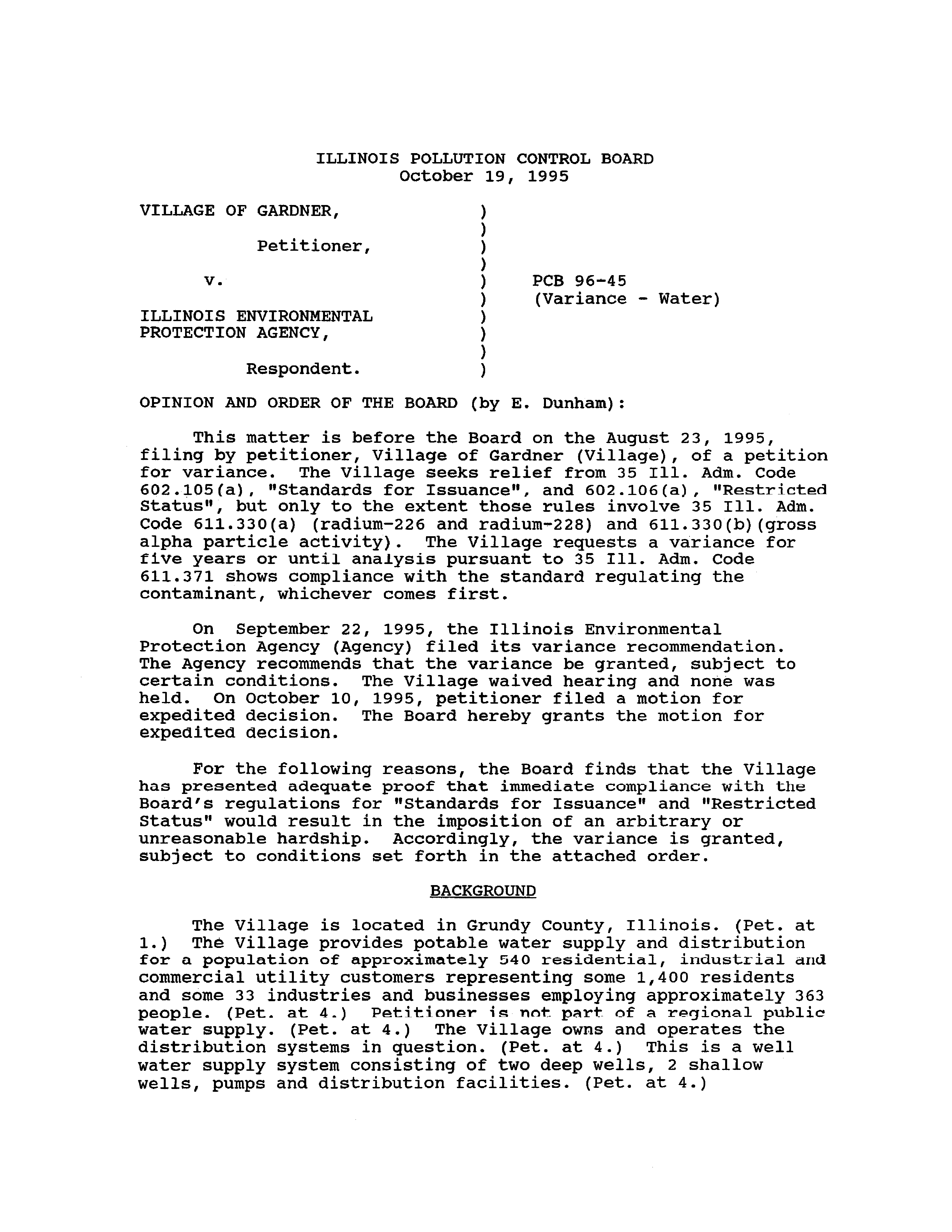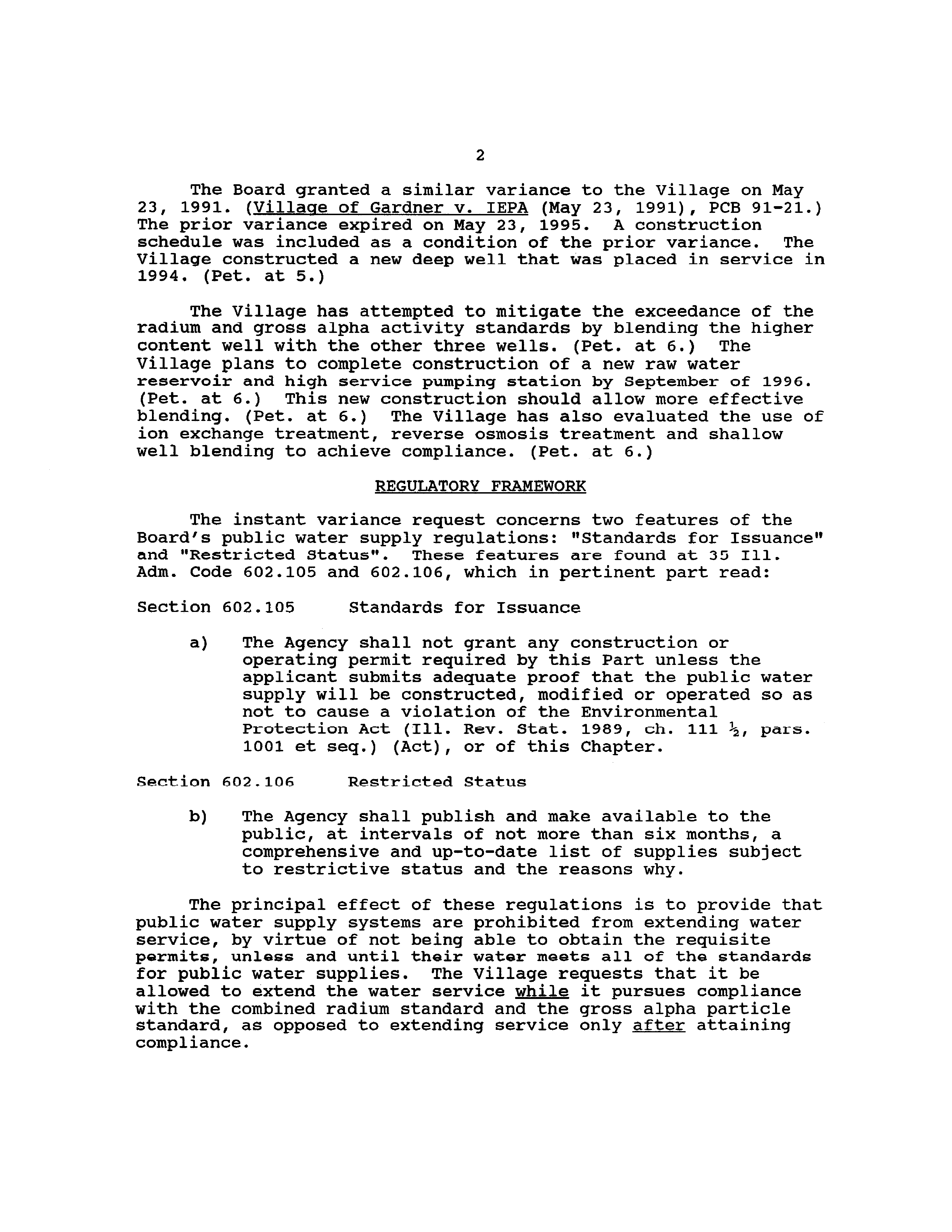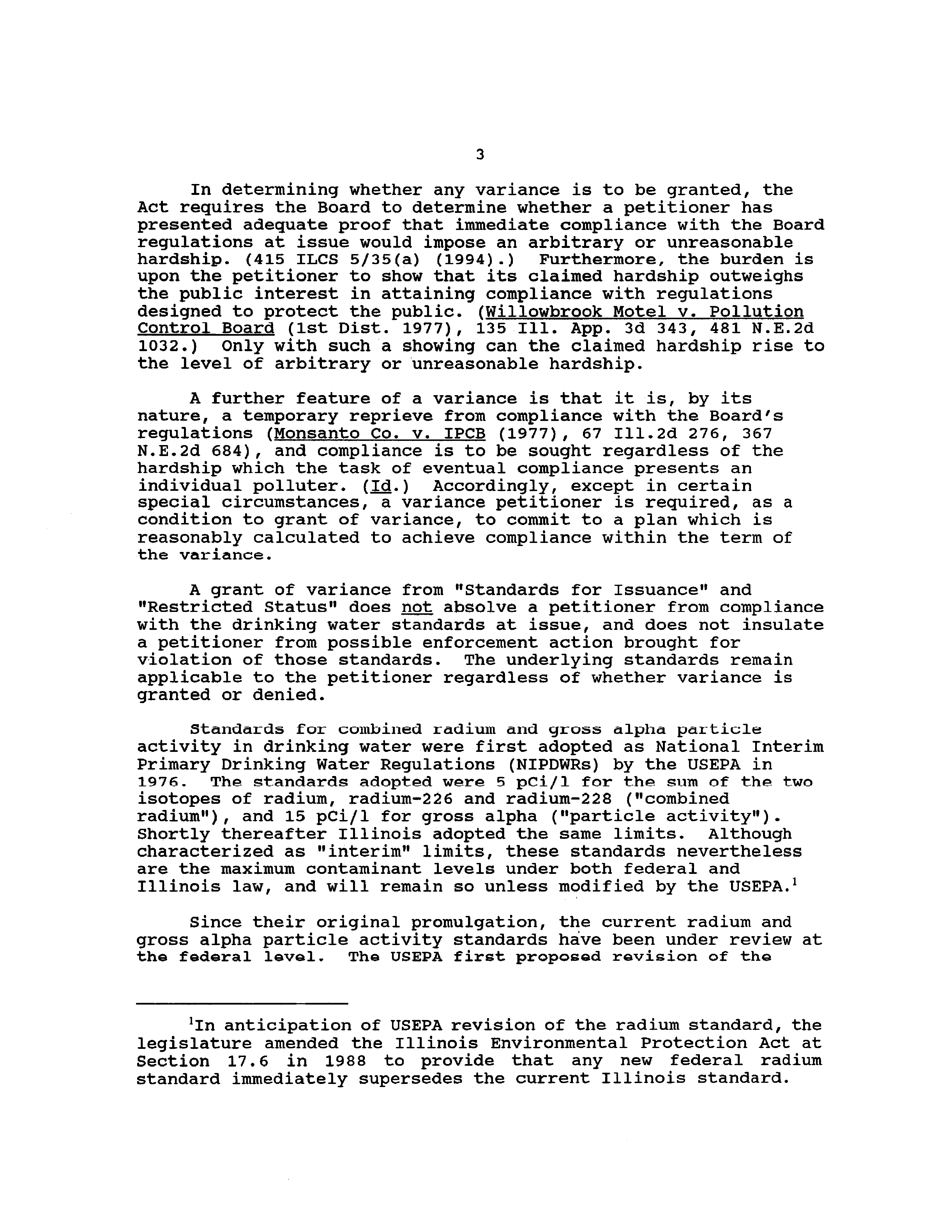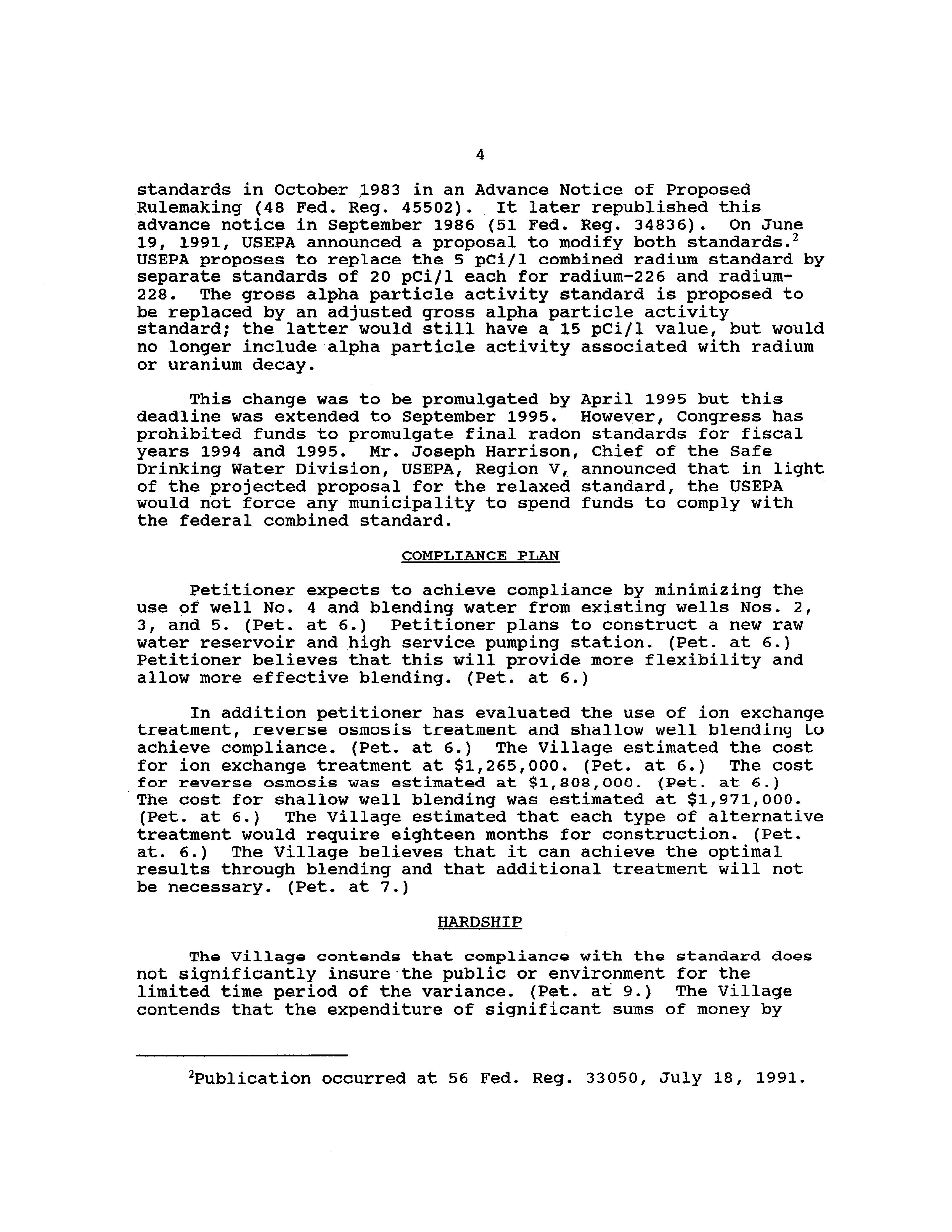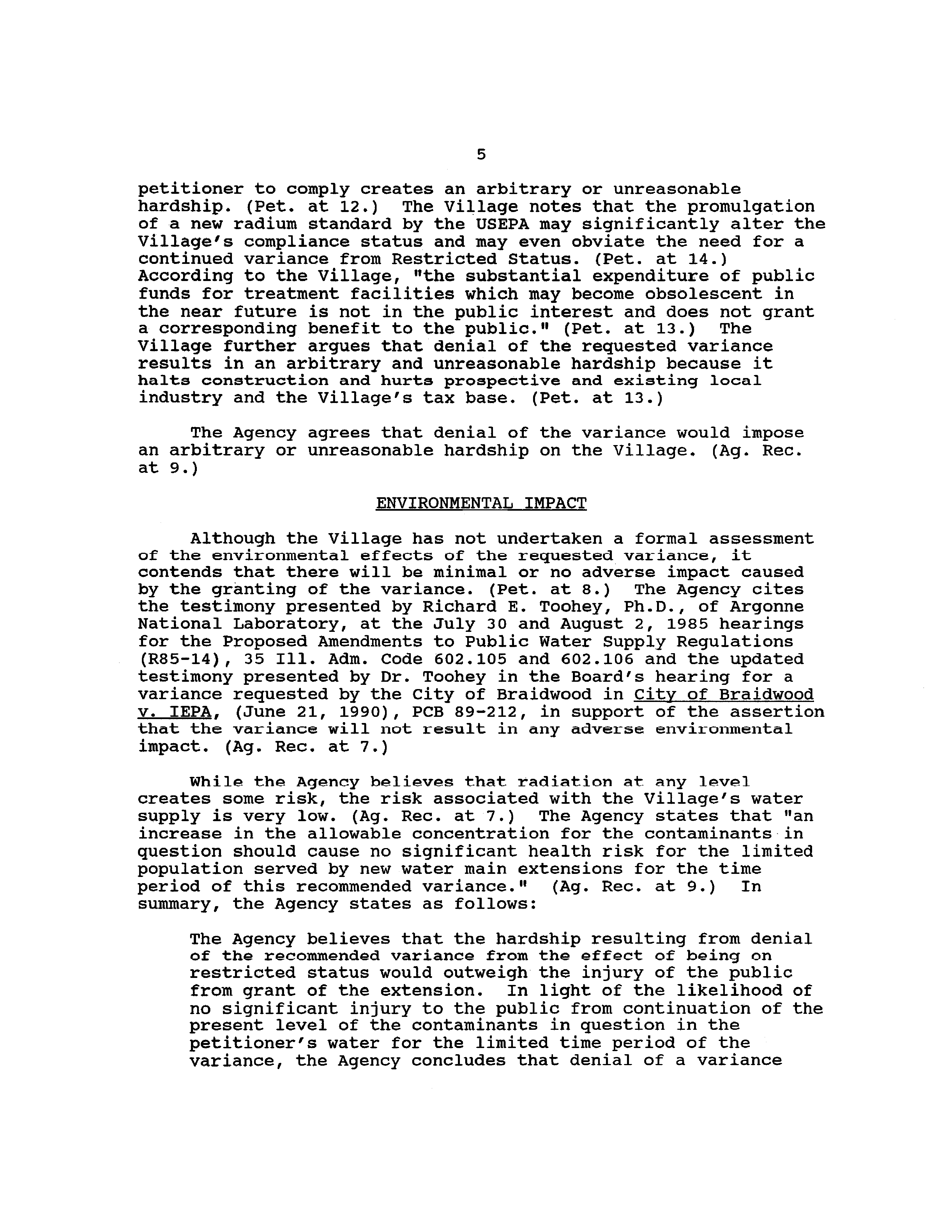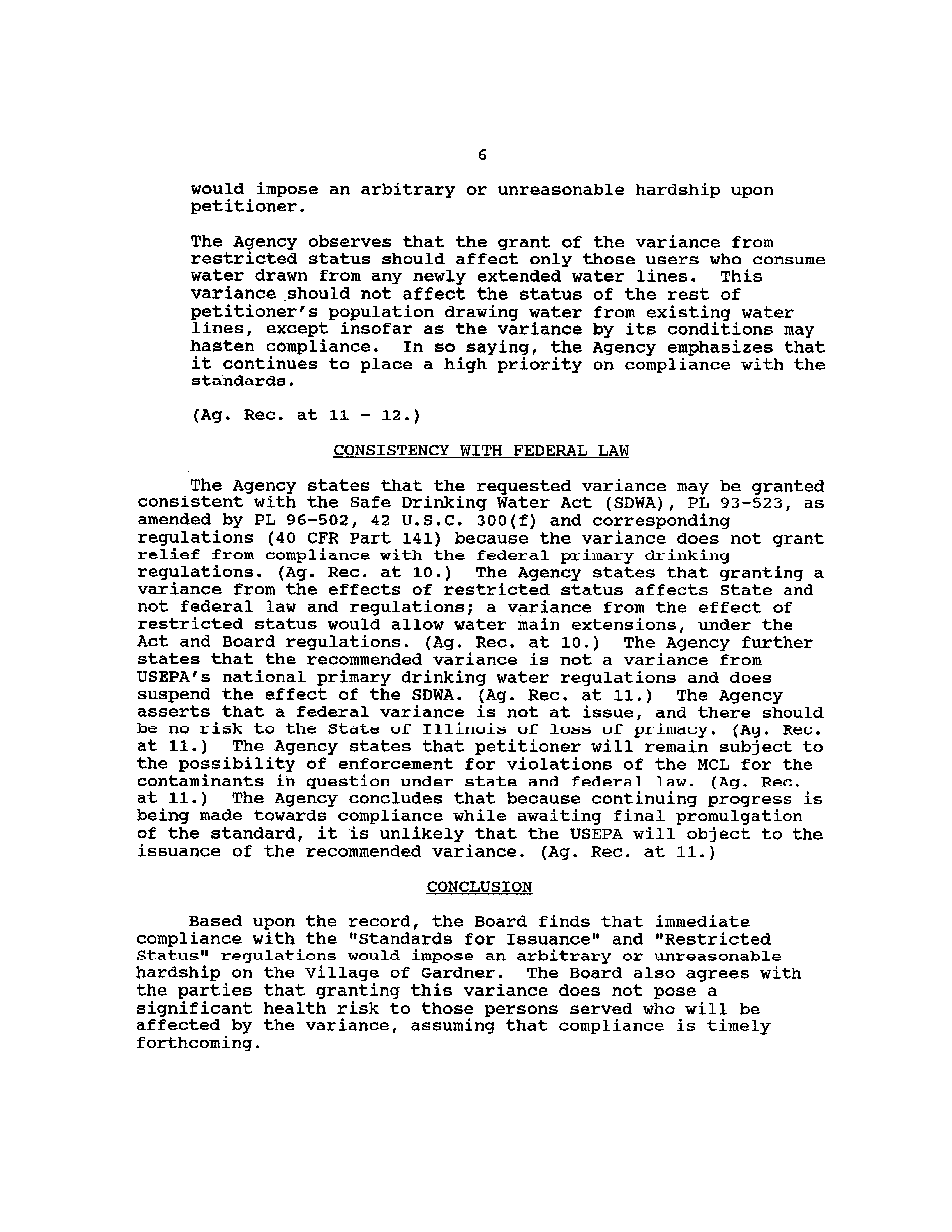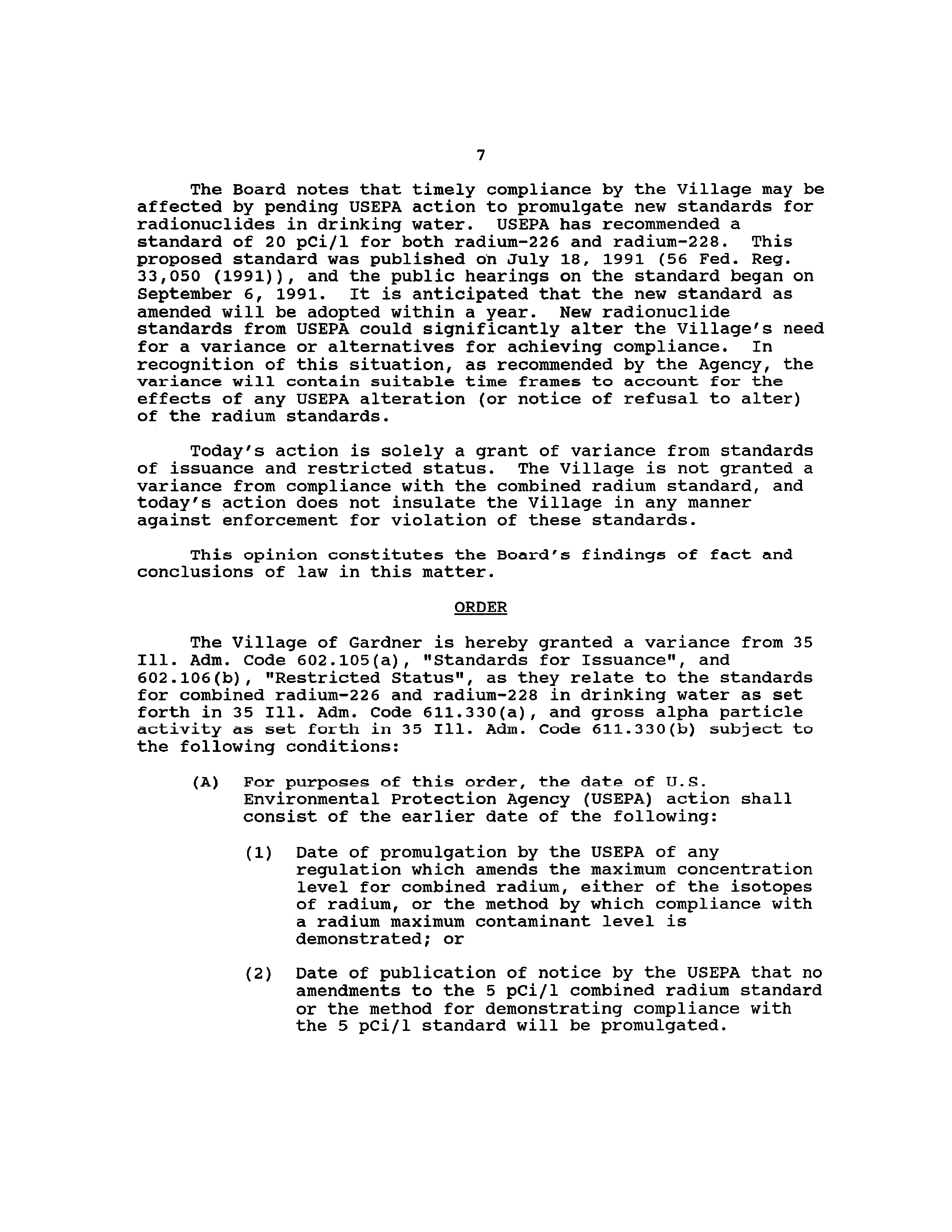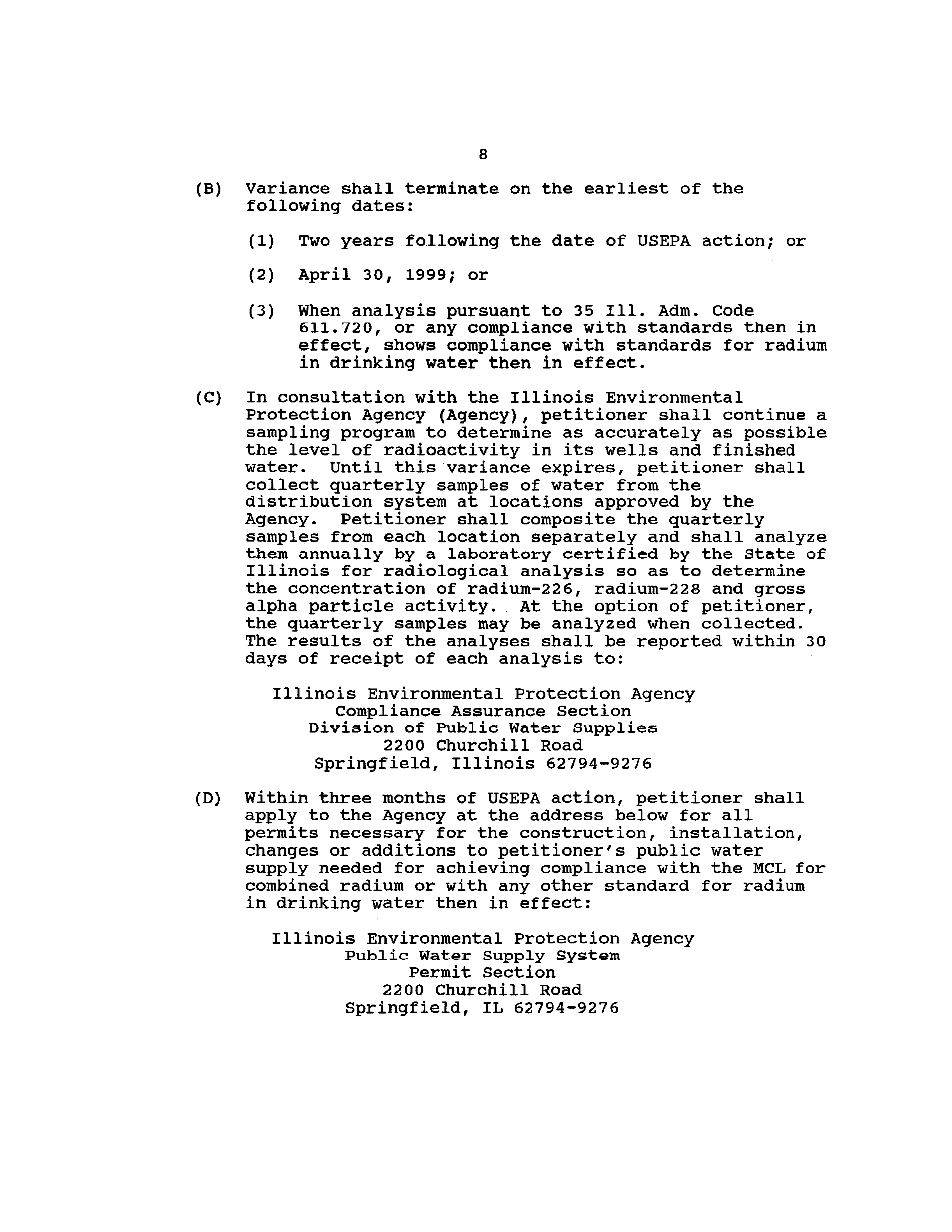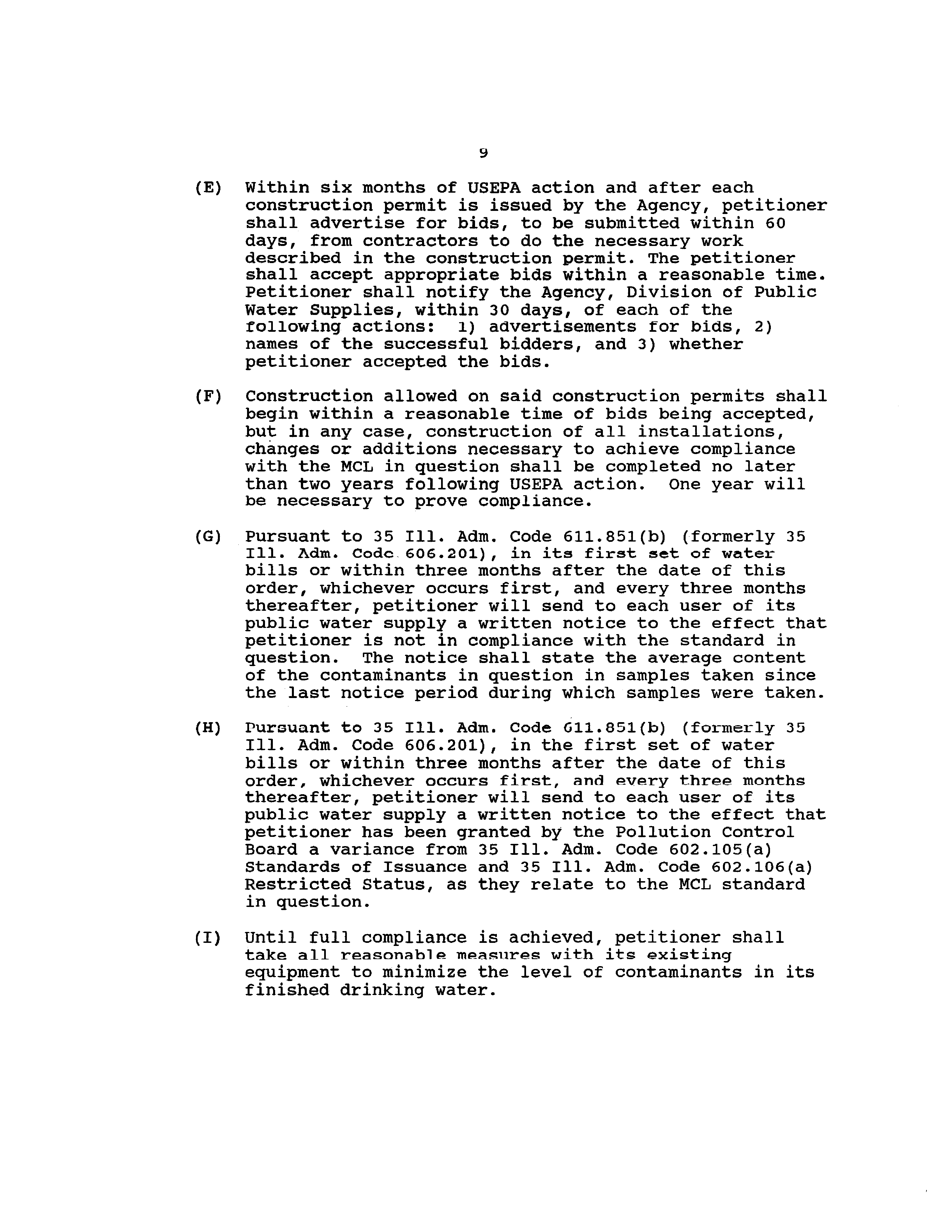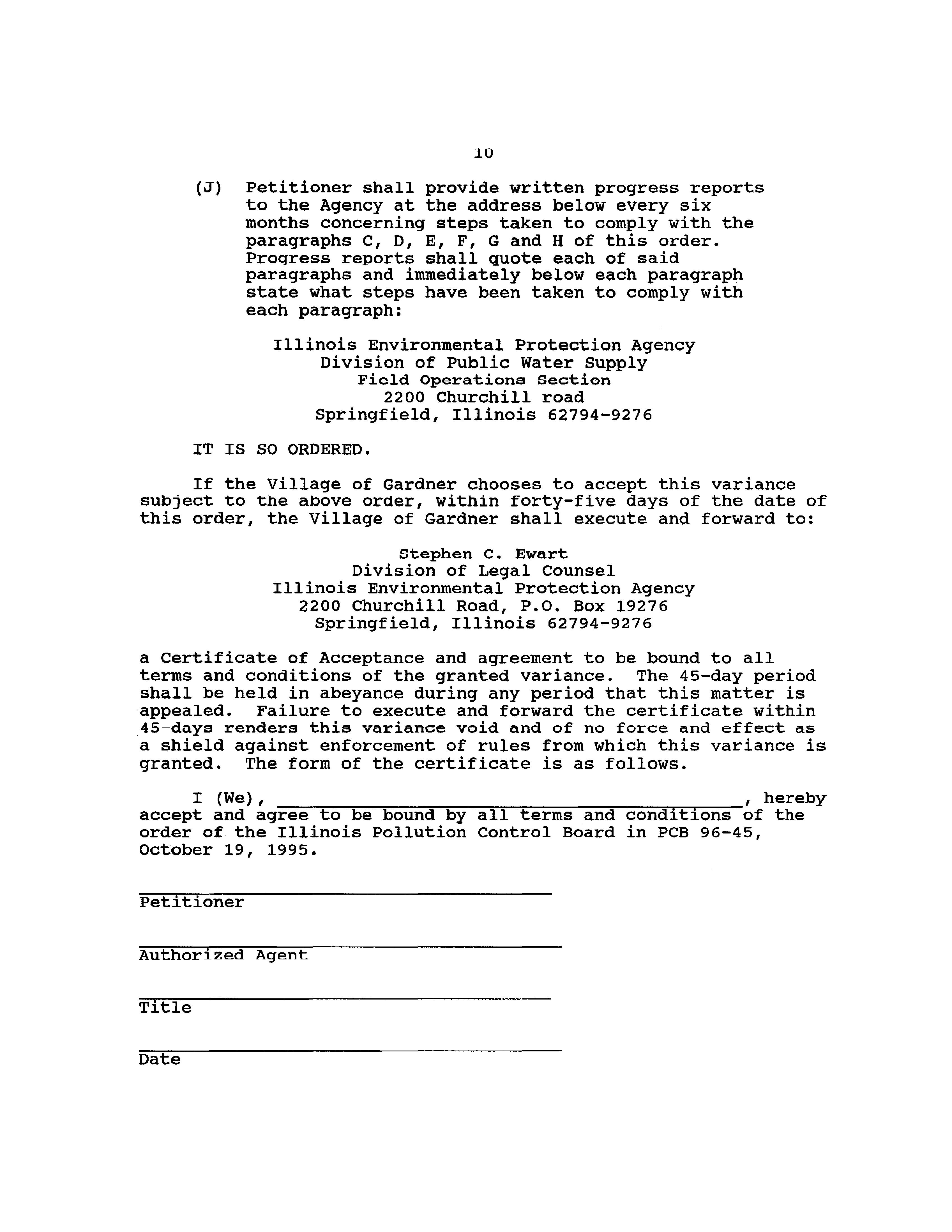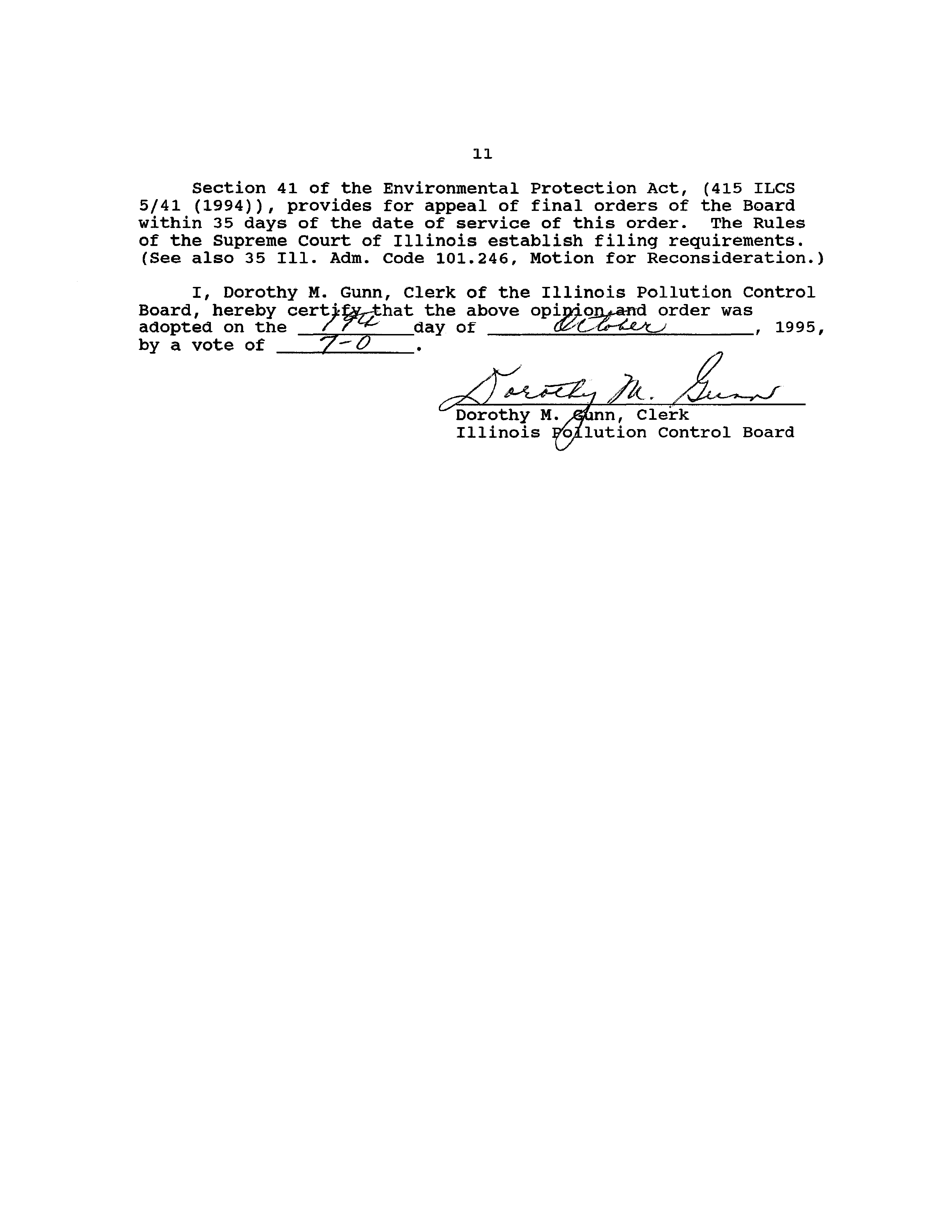ILLINOIS POLLUTION CONTROL BOARD
October 19, 1995
VILLAGE OF GARDNER,
)
Petitioner,
)
v.
)
PCB 96—45
)
(Variance
-
Water)
ILLINOIS ENVIRONMENTAL
)
PROTECTION AGENCY,
)
)
Respondent.
OPINION AND ORDER OF THE BOARD (by E. Dunham):
This matter is before the Board on the August 23, 1995,
filing by petitioner, Village of Gardner (Village), of a petition
for variance. The Village seeks relief from 35 Ill. Adm. Code
602.105(a), “Standards for Issuance”, and 602.106(a), “Restricted
Status”, but only to the extent those rules involve 35 Ill. Adm.
Code 611.330(a) (radiuin—226 and radium-228) and 611.330(b) (gross
alpha particle activity). The Village requests a variance for
five years or until analysis pursuant to 35 Iii. Adm. Code
611.371 shows compliance with the standard regulating the
contaminant, whichever comes first.
On September 22, 1995, the Illinois Environmental
Protection Agency (Agency) filed its variance recommendation.
The Agency recommends that the variance be granted, subject to
certain conditions. The Village waived hearing and none was
held. On October 10, 1995, petitioner filed a motion for
expedited decision. The Board hereby grants the motion for
expedited aecision.
For the following reasons, the Board finds that the Village
has presented adequate proof that immediate compliance with the
Board’s regulations for “Standards for Issuance” and “Restricted
Status” would result in the imposition of an arbitrary or
unreasonable hardship. Accordingly, the variance is granted,
subject to conditions set forth in the attached order.
BACKGROUND
The Village is located in Grundy County, Illinois. (Pet. at
1.) The Village provides potable water supply and distribution
for a population of approximately 540 residential, industrial and
commercial utility customers representing some 1,400 residents
and some 33 industries and businesses employing approximately 363
people. (Pet. at 4..) Petitioner ic~not part of a r~gionalpublic
water supply. (Pet. at 4.) The Village owns and operates the
distribution systems in question. (Pet. at 4.) This is a well
water supply system consisting of two deep wells, 2 shallow
wells, pumps and distribution facilities. (Pet. at 4.)
2
The Board granted a similar variance to the Village on May
23, 1991. (Village of Gardner v. IEPA (May 23, 1991), PCB 91—21.)
The prior variance expired on May 23, 1995. A construction
schedule was included as a condition of the prior variance. The
Village constructed a new deep well that was placed in service in
1994. (Pet. at 5.)
The Village has attempted to mitigate the exceedance of the
radium and gross alpha activity standards by blending the higher
content well with the other three welis. (Pet. at 6.) The
Village plans to complete construction of a new raw water
reservoir and high service pumping station by September of 1996.
(Pet. at 6.) This new construction should allow more effective
blending. (Pet. at 6.) The Village has also evaluated the use of
ion exchange treatment, reverse osmosis treatment and shallow
well blending to achieve compliance. (Pet. at 6)
REGULATORY FRAMEWORK
The instant variance request concerns two features of the
Board’s public water supply regulations: “Standards for Issuance”
and “Restricted Status”. These features are found at 35 Ill.
Adm. Code 602.105 and 602.106, which in pertinent part read:
Section 602.105
Standards for Issuance
a) The Agency shall not grant any construction or
operating permit required by this Part unless the
applicant submits adequate proof that the public water
supply will be constructed, modified or operated so as
not to cause a violation of the Environmental
Protection Act (Ill. Rev. Stat. 1989, ch. iii 1~, ~
1001 et seq.) (Act), or of this Chapter.
Section 602.106
Restricted Status
b) The Agency shall publish and make available to the
public, at intervals of not more than six months, a
comprehensive and up—to-date list of supplies sublect
to restrictive status and the reasons why.
The principal effect of these regulations is to provide that
public water supply systems are prohibited from extending water
service, by virtue of not being able to obtain the requisite
permits, unless and until their water meets all of the standards
for public water supplies. The Village requests that it be
allowed to extend the water service while it pursues compliance
with the combined radium standard and the gross alpha particle
standard, as opposed to extending service only after attaining
compliance.
3
In determining whether any variance is to be granted, the
Act requires the Board to determine whether a petitioner has
presented adequate proof that immediate compliance with the Board
regulations at issue would impose an arbitrary or unreasonable
hardship. (415 ILCS 5/35 (a) (1994).) Furthermore, the burden is
upon the petitioner to show that its claimed hardship outweighs
the public interest in attaining compliance with regulations
designed to protect the public. (Willowbrook Motel v. Pollution
Control Board (1st Dist. 1977), 135 Ill. App. 3d 343, 481 N.E.2d
1032.) Only with such a showing can the claimed hardship rise to
the level of arbitrary or unreasonable hardship.
A further feature of a variance is that it is, by its
nature, a temporary reprieve from compliance with the Board’s
regulations (Monsanto Co. v. IPCB (1977), 67 Ill.2d 276, 367
N.E.2d 684), and compliance is to be sought regardless of the
hardship which the task of eventual compliance presents an
individual polluter.
(u.)
Accordingly, except in certain
special circumstances, a variance petitioner is required, as a
condition to grant of variance, to commit to a plan which is
reasonably calculated to achieve compliance within the term of
the variance.
A grant of variance from “Standards for Issuance” and
“Restricted Status” does not absolve a petitioner from compliance
with the drinking water standards at issue, and does not insulate
a petitioner from possible enforcement action brought for
violation of those standards. The underlying standards remain
applicable to the petitioner regardless of whether variance is
granted or denied.
Standards for combined radium and gross alpha particle
activity in drinking water were first adopted as National Interim
Primary Drinking Water Regulations (NIPDWRs) by the USEPA in
1976. The standards adopted were s pci/i for the sum of the two
isotopes of radium, radium-226 and radium-228 (“combined
radium”), and 15 pCi/i for gross alpha (“particle activity”).
Shortly thereafter Illinois adopted the same limits. Although
characterized as “interim” limits, these standards nevertheless
are the maximum contaminant levels under both federal and
IllinoisSincelaw,theirandoriginalwillremainpromulgation,sounlessmodifiedthecurrentbyradiumtheUSEPA.and1
gross alpha particle activity standards have been under review at
the federal level. The USEPA first proposed revision of the
‘In anticipation of USEPA revision of the radium standard, the
legislature amended the Illinois Environmental Protection Act at
Section 17.6 in 1988 to provide that any new federal radium
standard immediately supersedes the current Illinois standard.
4
standards in October 1983 in an Advance Notice of Proposed
Rulemaking (48 Fed. Reg. 45502). It later republished this
advance notice in September 1986 (51 Fed. Reg. 34836). On Tune
USEPA19,
1991,proposesUSEPAtoannouncedreplace
thea
proposal5
pCi/itocombinedmodify
bothradiumstandards.standard2
by
separate standards of 20 pCi/i each for radium-226 and radium-
228. The gross alpha particle activity standard is proposed to
be replaced by an adjusted gross alpha particle activity
standard; the latter would still have a 15 pCi/i value, but would
no longer include alpha particle activity associated with radium
or uranium decay.
This change was to be promulgated by April 1995 but this
deadline was extended to September 1995. However, Congress has
prohibited funds to promulgate final radon standards for fiscal
years 1994 and 1995. Mr. Joseph Harrison, Chief of the Safe
Drinking Water Division, USEPA, Region V, announced that in light
of the projected proposal for the relaxed standard, the USEPA
would not force any municipality to spend funds to comply with
the federal combined standard.
COMPLIANCE PLAN
Petitioner expects to achieve compliance by minimizing the
use of well No. 4 and blending water from existing wells Nos. 2,
3, and 5. (Pet. at 6.) Petitioner plans to construct a new raw
water reservoir and high service pumping station. (Pet. at 6.)
Petitioner believes that this will provide more flexibility and
allow more effective blending. (Pet. at 6.)
In addition petitioner has evaluated the use of ion exchange
treatment, reverse osmosis treatment and shallow well blendiriy Lu
achieve compliance. (Pet. at 6.) The Village estimated the cost
for ion exchange treatment at $1,265,000. (Pet. at 6.) The cost
for reverse osmosis was estimated at $1,808,000. (Pet.. at 6.)
The cost for shallow well blending was estimated at $1,971,000.
(Pet. at 6.) The Village estimated that each type of alternative
treatment would require eighteen months for construction. (Pet.
at. 6.) The Village believes that it can achieve the optimal
results through blending and that additional treatment will not
be necessary. (Pet. at 7.)
HARDSHIP
The Village contends that compliance with the
standard does
not significantly insure the public or environment for the
limited time period of the variance. (Pet. at 9.) The Village
contends that the expenditure of significant sums of money by
2Publication occurred at 56 Fed. Reg. 33050, July 18, 1991.
5
petitioner to comply creates an arbitrary or unreasonable
hardship. (Pet.
at 12,) The Village notes that the promulgation
of a new
radium standard by the USEPA may significantly alter the
Village’s compliance status and
may even obviate the need for a
continued variance from
Restricted Status. (Pet. at 14.)
According to the Village, “the substantial expenditure of public
funds for
treatment facilities which
may become obsolescent in
the near future is not in the public interest and does not grant
a corresponding benefit to the public.” (Pet. at 13.) The
Village further argues that denial of the requested variance
results in an arbitrary and unreasonable hardship because it
halts construction and hurts prospective and existing local
industry and the Village’s tax base. (Pet. at 13.)
The Agency agrees that denial of the variance would impose
an arbitrary or unreasonable hardship on the Village. (Ag. Rec.
at 9.)
ENVIRONMENTAL IMPACT
Although the Village has not undertaken a formal assessment
of the environmental effects of the requested variance, it
contends that there will be minimal or no adverse impact caused
by the granting of the variance. (Pet. at 8.) The Agency cites
the testimony presented by Richard E. Toohey, Ph.D., of Argonne
National Laboratory, at the July 30 and August 2, 1985 hearings
for the Proposed Amendments to Public Water Supply Regulations
(R85-l4), 35 Ill. Adm. Code 602.105 and 602.106 and the updated
testimony presented by Dr. Toohey in the Board’s hearing for a
variance requested by the City of Braidwood in City of Braidwood
v. IEPA, (June 21, 1990), PCB 89-212, in support of the assertion
that the variance will not result
in
any adverse environmental
impact. (Ag. Rec. at 7.)
While the Agency believes that radiation at any level
creates some risk, the risk associated with the Village’s water
supply is very low. (Ag. Rec. at 7.)
The Agency states that “an
increase in the allowable concentration for the contaminants in
question should cause no significant health risk for the limited
population served by new water main extensions for the time
period of this recommended variance.”
(Ag. Rec. at 9.)
In
summary, the Agency states as follows:
The Agency
believes that the hardship resulting from
denial
of the recommended variance from the effect of being on
restricted status would outweigh the injury of the public
from grant of the extension. In light of the likelihood of
no significant injury to the public from continuation of the
present level of the contaminants in question in the
petitioner’s water for the limited time period of the
variance, the Agency concludes that denial of a variance
6
would impose an arbitrary or unreasonable hardship upon
petitioner.
The Agency observes that the grant of the variance from
restricted status should affect only those users who consume
water drawn from any newly extended water lines. This
variance ~should not affect the status of the rest of
petitioner’s population drawing water from existing water
lines, except insofar as the variance by its conditions may
hasten compliance. In so saying, the Agency emphasizes that
it continues to place a high priority on compliance with the
standards.
(Ag. Rec. at 11
-
12.)
CONSISTENCY WITH FEDERAL LAW
The Agency states that the requested variance may be granted
consistent with the Safe Drinking Water Act (SDWA), PL 93-523, as
amended by PL 96-502, 42 U.S.C. 300(f) and corresponding
regulations (40 CFR Part 141) because the variance does not grant
relief from compliance with the federal primary drinking
regulations. (Ag. Rec. at 10.) The Agency states that granting a
variance from the effects of restricted status affects State and
not federal law and regulations; a variance from the effect of
restricted status would allow water main extensions, under the
Act and Board regulations. (Ag. Rec. at 10.) The Agency further
states that the recommended variance is not a variance from
USEPA’s national primary drinking water regulations and does
suspend the effect of the SDWA. (Ag. Rec. at 11.) The Agency
asserts that a federal variance is not at issue, and there should
be no risk to the State of Illinois or loss or primacy. (Ag. Ree.
at 11.) The Agency states that petitioner will remain subject to
the possibility of enforcement for violations of the MCL for the
contaminants in question under state and federal law. (Ag. Rec.
at 11.) The Agency concludes that because continuing progress is
being made towards compliance while awaiting final promulgation
of the standard, it is unlikely that the USEPA will object to the
issuance of the recommended variance. (Ag. Rec. at 11.)
CONCLUSION
Based upon the record, the Board finds that immediate
compliance with the “Standards for Issuance” and “Restricted
Status” regulations would impose an arbitrary or unreasonable
hardship on the Village of Gardner. The Board also agrees with
the parties that granting this variance does not pose a
significant health risk to those persons served who will be
affected by the variance, assuming that compliance is timely
forthcoming.
7
The Board notes that timely compliance by the Village may be
affected by pending USEPA action to promulgate new standards for
radionuclides in drinking water. USEPA has recommended a
standard of 20 pCi/l for both radium-226 and radium-228. This
proposed standard was published on July 18, 1991 (56 Fed. Reg.
33,050 (1991)), and the public hearings on the standard began on
September 6, 1991. It is anticipated that the new standard as
amended will be adopted within a year. New radionuclide
standards from USEPA could significantly alter the Village’s need
for a variance or alternatives for achieving compliance. In
recognition of this situation, as recommended by the Agency, the
variance will contain suitable time frames to account for the
effects of any USEPA alteration (or notice of refusal to alter)
of the radium standards.
Today’s action is solely a grant of variance from standards
of issuance and restricted status. The Village is not granted a
variance from compliance with the combined radium standard, and
today’s action does not insulate the Village in any manner
against enforcement for violation of these standards.
This opinion constitutes the Board’s findings of fact and
conclusions of law in this matter.
ORDER
The Village of Gardner is hereby granted a variance from 35
Ill. Adm. Code 602.105(a), “Standards for Issuance”, and
602.106(b), “Restricted Status”, as they relate to the standards
for combined radium-226 and radium-228 in drinking water as set
forth in 35 Ill. Adin. Code 611.330(a), and gross alpha particle
activity as set forth in 35 Ill. Adm. Code 611.330(b) subject to
the following conditions:
(A) For purposes of this order, the date of U.S.
Environmental Protection Agency (USEPA) action shall
consist of the earlier date of the following:
(1) Date of promulgation by the USEPA of any
regulation which amends the maximum concentration
level for combined radium, either of the isotopes
of radium, or the method by which compliance with
a radium maximum contaminant level is
demonstrated; or
(2) Date of publication of notice by the USEPA that no
amendments to the 5 pCi/i combined radium standard
or the method for demonstrating compliance with
the 5 pCi/i standard will be promulgated.
8
(B) Variance shall terminate on the earliest of the
following dates:
(1) Two years following the date of USEPA action; or
(2) April 30, 1999; or
(3) When analysis pursuant to 35 Ill. Adm. Code
611.720, or any compliance with standards then in
effect, shows compliance with standards for radium
in drinking water then in effect.
(C) In consultation with the Illinois Environmental
Protection Agency (Agency), petitioner shall continue a
sampling program to determine as accurately as possible
the level of radioactivity in its wells and finished
water. Until this variance expires, petitioner shall
collect quarterly samples of water from the
distribution system at locations approved by the
Agency. Petitioner shall composite the quarterly
samples from each location separately and shall analyze
them annually by
a laboratory certified by the State of
Illinois for radiological analysis so as to determine
the concentration of radium-226, radium-228 and gross
alpha particle activity.
At the option of petitioner,
the quarterly samples may be analyzed when collected.
The results of the analyses shall be reported within 30
days of receipt of each analysis to:
Illinois Environmental Protection Agency
Compliance Assurance Section
Division of Public Water Supplies
2200 Churchill Road
Springfield, Illinois 62794—9276
(D) Within three months of USEPA action, petitioner shall
apply to the Agency at the address below for all
permits necessary for the construction, installation,
changes or additions to petitioner’s public water
supply needed for achieving compliance with the MCL for
combined radium or with any other standard for radium
in drinking water then in effect:
Illinois Environmental Protection Agency
Public Water Supply System
Permit Section
2200 Churchill Road
Springfield, IL 62794—9276
9
(E) Within six months of USEPA action and after each
construction permit is issued by the Agency, petitioner
shall advertise for bids, to be submitted within 60
days, from contractors to do the necessary work
described in the construction permit. The petitioner
shall accept appropriate bids within a reasonable time.
Petitioner shall notify the Agency, Division of Public
Water Supplies, within 30 days, of each of the
rollowing actions: 1) advertisements for bids, 2)
names of the successful bidders, and 3) whether
petitioner accepted the bids.
(F) Construction allowed on said construction permits shall
begin within a reasonable time of bids being accepted,
but in any case, construction of all installations,
changes or additions necessary to achieve compliance
with the MCL in question shall be completed no later
than two years following USEPA action. One year will
be necessary to prove compliance.
(G) Pursuant to 35 Ill. Adm. Code 611.851(b) (formerly 35
Ill. Adm. Code. 606.201), in its first set of water
bills or within three months after the date of this
order, whichever occurs first, and every three months
thereafter, petitioner will send to each user of its
public water supply a written notice to the effect that
petitioner is not in compliance with the standard in
question. The notice shall state the average content
of the contaminants in question in samples taken since
the last notice period during which samples were taken.
(H) Pursuant to 35 Ill. Adm. Code 611.851(b) (formerly 35
Ill. Adm. Code 606.201), in the first set of water
bills or within three months after the date of this
order, whichever occurs first, and every three months
thereafter, petitioner will send to each user of its
public water supply a written notice to the effect that
petitioner has been granted by the Pollution Control
Board a variance from 35 Ill. Adiu. Code 602.105(a)
Standards of Issuance and 35 Ill. Adm. Code 602.106(a)
Restricted Status, as they relate to the MCL standard
in question.
(I) Until full compliance is achieved, petitioner shall
take all
reasonable measures with its existing
equipment to minimize the level of contaminants in its
finished drinking water.
(J) Petitioner shall provide written progress reports
to the Agency at the address below every six
months concerning steps taken to comply with the
paragraphs C, D, E, F, G and H of this order.
Progress reports shall quote each of said
paragraphs and immediately below each paragraph
state what steps have been taken to comply with
each paragraph:
Illinois Environmental Protection Agency
Division of Public Water Supply
Field Operations Section
2200 Churchill road
Springfield, Illinois 62794—9276
IT IS SO ORDERED.
If the Village of Gardner chooses to accept this variance
subject to the above order, within forty-five days of the date of
this order, the Village of Gardner shall execute and forward to:
Stephen C. Ewart
Division of Legal Counsel
Illinois Environmental Protection Agency
2200 Churchill Road, P.O. Box 19276
Springfield, Illinois 62794—9276
a Certificate of Acceptance and agreement to be bound to all
terms and conditions of the granted variance. The 45-day period
shall be held in abeyance during any period that this matter is
appealed. Failure to execute and forward the certificate within
45—days renders this variance void and of no force and effect as
a shield against enforcement of rules from which this variance is
granted. The form of the certificate is as follows.
I (We),
,
hereby
accept and agree to be bound by all terms and conditions of the
order of the Illinois Pollution Control Board in PCB 96-45,
October 19, 1995.
Petitioner
Authorized Agent
Title
Date
11
Section 41 of the Environmental Protection Act, (415 ILCS
5/41 (1994)), provides for appeal of final orders of the Board
within 35 days of the date of service of this order. The Rules
of the Supreme Court of Illinois establish filing requirements.
(See also 35 Ill. Adm. Code 101.246, Motion for Reconsideration.)
I, Dorothy M. Gunn, Clerk of the Illinois Pollution Control
Board, hereby cert -that the above opi~oj~andorder was
adopted on the
i’
7~’- day of
~
,
1995,
by a vote of
7—O
Dorothy M. A~’flfl, Clerk
Illinois ~blution Control Board
